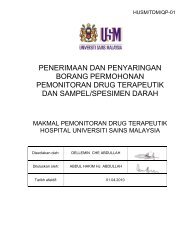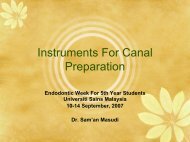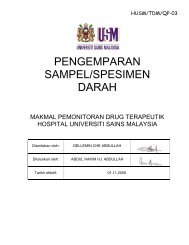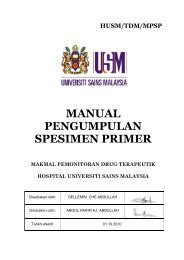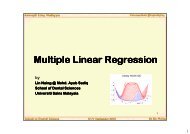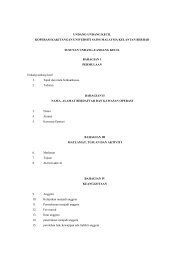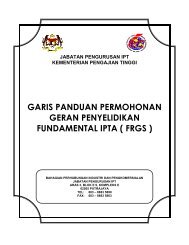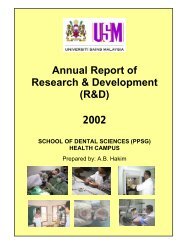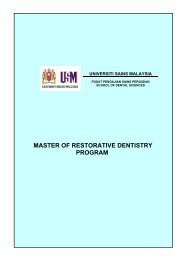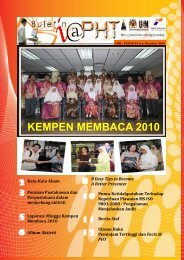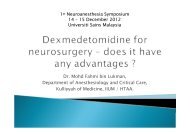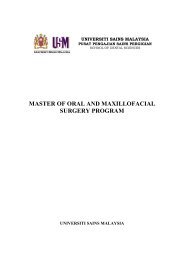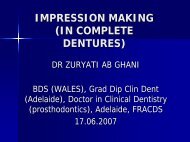Vol 11-R2- Eyelid
Vol 11-R2- Eyelid
Vol 11-R2- Eyelid
You also want an ePaper? Increase the reach of your titles
YUMPU automatically turns print PDFs into web optimized ePapers that Google loves.
SRPS • <strong>Vol</strong>ume <strong>11</strong> • Issue <strong>R2</strong> • 2010<br />
Fifteen patients underwent reconstruction of at<br />
least three-fourths of the eyelid. The procedure<br />
was derived from a description by Micali et al. 78 of<br />
a full-thickness mucosal-chondrocutaneous flap<br />
harvested from the lateral side of the nose, including<br />
part of the triangular and sesamoid cartilages.<br />
Scuderi et al. modified the method by using an<br />
ipsilateral axial chondromucosal flap to recreate the<br />
posterior lamella. They initially used a local skin flap<br />
for cutaneous coverage and later changed to using<br />
a skin graft because of the bulkiness of the flap.<br />
Scuderi et al. described the surgical technique<br />
as follows:<br />
16<br />
“After the skin is incised for 2.5 cm along<br />
the border between the lateral nasal wall<br />
and the cheek from the inner canthus to<br />
the ala nasi, the periosteum is dissected<br />
from lateral to medial, up to and beyond<br />
the midline of the nose. Dissection is<br />
extended superiorly to the inner canthus<br />
and glabella and inferiorly to the lower<br />
margin of the nasal bones. Then, the<br />
subcutaneous tissue is dissected, always<br />
from lateral to medial, onto a line beyond<br />
the midline of the nose, where it joins<br />
the subperiosteal plane. The subcutaneous<br />
dissection is extended superiorly to the<br />
glabellar area and inferiorly to or beyond<br />
the lower margin of the upper lateral<br />
cartilages. Distally, the flap is harvested<br />
including the cranial portion of the<br />
upper lateral cartilage, depending on<br />
the size of the defect to repair, and the<br />
corresponding nasal mucosa. The flap<br />
is then transposed to reconstruct the<br />
posterior lamella of the missing eyelid,<br />
flap mucosa is sutured to the conjunctival<br />
margin (separating it from the fornix if<br />
necessary), and the levator muscle stump<br />
is inserted into the cartilaginous portion<br />
of the flap. This simulates insertion of the<br />
levator muscle into the tarsal plate.”<br />
With this technique, a skin graft is used for the<br />
anterior lamella. The nasal lining donor defect is<br />
repaired with direct closure using absorbable sutures<br />
or can be left to heal spontaneously, and the skin is<br />
closed with fine nylon. 77<br />
The procedure modified by Scuderi et al. 77<br />
resulted in a viable flap in every patient, without<br />
total or partial necrosis. Static parameters were<br />
within normal ranges: levator function was 8 to 18<br />
mm (mean, 13 mm), and eyelid length was 25 to<br />
30 mm (mean, 29.2 mm). Patients were generally<br />
pleased with the results. Complications included<br />
lagophthalmos in one case, orbital emphysema in<br />
one, and corneal abrasions in three.<br />
Acellular human dermis (AlloDerm; LifeCell<br />
Corporation, Branchburg, NJ), is a cadaveric dermal<br />
graft that has been enzymatically processed to<br />
remove all cellular material to leave only an acellular<br />
and immunologically inert collagen matrix. The<br />
dermal framework promotes fibroblast immigration,<br />
neovascularization, and collagen deposition. 57,74 In<br />
postoperative animal studies, the matrix is replaced<br />
by host cells. 79 Li et al. 74 compared 35 patients<br />
undergoing AlloDerm grafting with 25 patients<br />
undergoing hard palate grafting of the lower eyelid<br />
after postoperative cicatricial changes. The lower<br />
eyelid heights were measured. No statistically<br />
significant difference was found between the<br />
AlloDerm and hard palate groups, although a trend<br />
was observed that hard palate grafts resulted in<br />
both better elevation and a lower failure rate.<br />
Female patients in both groups were found to<br />
experience significantly greater eyelid elevation<br />
than male patients.<br />
Taban et al. 57 evaluated the long-term<br />
efficacy of a thick AlloDerm graft in lower eyelid<br />
reconstruction compared with previous results for<br />
thin AlloDerm and hard palate grafts. The results<br />
showed similar rates of success and final eyelid<br />
height position.<br />
An alternative material that can be used in<br />
place of tarsus is a product known as Enduragen,<br />
which is a porcine acellular dermal collagen matrix<br />
manufactured by Tissue Science Laboratories<br />
(Aldershot, United Kingdom). McCord et al. 80<br />
described the first experiences with Enduragen<br />
as a spacer graft in 69 patients and 129 eyelids



